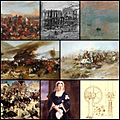1870s facts for kids
The 1870s was a decade full of amazing inventions and big changes around the world. It was a time when new technologies like the telephone and the phonograph were created, changing how people communicated and enjoyed music. Many countries also saw important political shifts, with new nations forming and empires expanding.
Contents
Amazing Inventions of the 1870s
This decade brought us some truly groundbreaking inventions that shaped the future.
How the Telephone Changed Communication
In 1876, Alexander Graham Bell invented the telephone. This incredible device allowed people to talk to each other over long distances for the very first time. Before the telephone, messages were sent by mail or telegraph, which was much slower. The telephone made communication almost instant, connecting people like never before.
The Bright Idea: The Light Bulb
The light bulb was also invented during this period. While many people worked on electric lighting, Thomas Edison created a practical and long-lasting light bulb in 1879. This invention meant homes and streets could be lit up at night, making life safer and more productive after dark.
Listening to the Past: The Phonograph
In 1877, Thomas Edison also invented the phonograph. This was the first machine that could record and play back sounds. Imagine being able to listen to music or speeches whenever you wanted! The phonograph was a huge step towards modern music players and recording technology.
Big Changes Around the World
The 1870s was a time of major political events and shifts in power across different continents.
The Franco-Prussian War and New Nations
The Franco-Prussian War took place from 1870 to 1871. This conflict was between the Second French Empire and the Kingdom of Prussia, along with its German allies. Prussia won the war, which led to two major outcomes:
- The end of the Second French Empire and the start of the French Third Republic.
- The formation of the German Empire, uniting many smaller German states under one rule.
The British Empire Grows Stronger
The British Empire continued to expand during the 1870s. This period is often called the beginning of the "New Imperialism." It meant that powerful European countries, especially Britain, were taking control of more lands in Africa and Asia. They did this to gain resources, new markets for their goods, and to show their power.
New Countries in Europe: Bulgaria and Romania
Following the Russo-Turkish War (1877–1878), two new countries declared their independence: Bulgaria and Romania. This war involved the Russian Empire fighting against the Ottoman Empire. When the war ended, it allowed these nations, which had been under Ottoman rule, to become independent.
Reconstruction Ends in the United States
In the United States, the period after the American Civil War was known as Reconstruction. This was a time when the country tried to rebuild and bring the Southern states back into the Union, while also dealing with the rights of newly freed enslaved people. Reconstruction officially ended in 1877 under President Rutherford B. Hayes.
Important Leaders of the 1870s
Many important leaders guided their countries through the changes of this decade.
European Monarchs and Prime Ministers
- Emperor Franz Josef led Austria-Hungary.
- Emperor Wilhelm I was the first emperor of the new German Empire.
- Otto von Bismarck was the powerful Chancellor of the German Empire, known for uniting Germany.
- Queen Victoria ruled the United Kingdom and its vast empire.
- William Ewart Gladstone and Benjamin Disraeli were two important Prime Ministers of the United Kingdom.
- Emperor Alexander II ruled Russia.
- Pope Pius IX and later Pope Leo XIII were the leaders of the Catholic Church.
Leaders in Asia and the Americas
- Emperor Meiji was the emperor of Japan during a time of rapid modernization.
- Nasser-al-Din Shah led Persia (modern-day Iran).
- John A. Macdonald and Alexander Mackenzie served as Prime Ministers of Canada.
- In the United States, Ulysses S. Grant and Rutherford B. Hayes were presidents.
Images for kids
-
From left to right, clockwise: Conflict erupts between the Second French Empire and the Kingdom of Prussia leading to the Franco-Prussian War in 1870; a fire in Chicago kills approximately 300 people and leaves about another 100,000 people homeless in 1871; Claude Monet's Impression, Sunrise is recognized as the source of inspiration for the Impressionism movement; The United States Army is defeated by Arapaho, Lakota and Northern Cheyenne tribes during the Battle of the Little Bighorn in 1876; Nicolaus Otto patents the first commercial four-stroke internal combustion engine; Queen Victoria is recognized as the “Empress of India” in the Royal Titles Act 1876; Emirate of Afghanistan forces defend against British Raj invaders in the Second Anglo-Afghan War; British Empire and Zulu Kingdom fighters engage in combat during the Anglo-Zulu War.
-
A scene from the Franco-Prussian War.
-
Photograph of Edison with his phonograph, taken by Mathew Brady in 1877.
-
The first version of the light bulb was invented by Thomas Edison in 1879.
See also
 In Spanish: Años 1870 para niños
In Spanish: Años 1870 para niños





